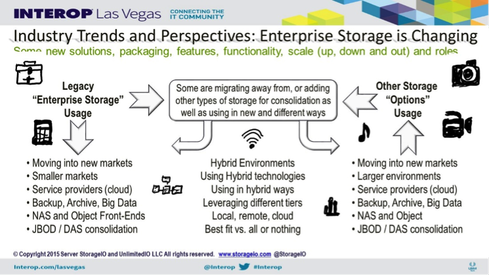A common question I am asked is, "What is the best storage technology?" My routine answer is, "It depends!" During my recent Interop Las Vegas session "Smart Shopping for Your Storage Strategy" I addressed this very question.
I often observe people deciding on the best storage before the questions of requirements, needs and wants are even mentioned. This is usually tied to a game of Buzzword Bingo -- you know, that game where somebody starts naming off industry trends and buzzwords until you say, "Okay, that's enough; let's focus on the challenge or opportunity, and then come back to the buzzwords." Buzzword examples include object storage, software defined storage, hybrid, , flash SSD, AFA (all flash array), APA (all purpose array), converged or hyperconverged infrastructure, scale-out, scale-up, VSAN, elastic, ephemeral, data lake, pond or ocean…. You get my point.
Thus the best storage solution will be the one that protects, preserves and serves your information for your organization, as well as one that works for you -- instead of you working for it. By that I mean that the best storage solution, product or technology should adapt to and fit your environment. This means being able to meet your various application performance, availability, capacity and economic (e.g. PACE) needs, while also complementing existing technologies, tools and expertise.
The best storage depends on what you need the storage to do. Ask yourself the following questions:
- Will the storage solution be used for all of your storage needs, or is it for a particular business function or application?
- Do you need to converge your servers and storage into a consolidated platform, or do you need storage that can be shared and accessed from many different virtual and physical servers?
- Does your environment require high performance (bandwidth, IOPs or low latency), or high capacity for static data?
- What type of availability and durability does the storage need?
- What associated data services (snapshot, replication, thin-provisioning, access, etc.) and management capabilities do you need?
The best storage, product, service, or technology and how you package it will depend on what you need (or want) it to do. A solution for primary active storage will be different from one for secondary bulk storage or tertiary data protection. Storage specific to an application also has different requirements that storage provides a deterministic, predictable quality of service overall. Or perhaps you simply need the most storage space capacity at the lowest cost because you will be configuring it with other data and storage management software tools to improve performance, availability and management.
During my Interop session on storage decision making, one of my major recommendations was to take a step back and outline your exact storage needs. Define your business' needs vs. wants (what you would like to have, or what somebody else wants or needs you to have). Once you develop solid requirements, you can start narrowing down the field of products. You may lean toward single storage solution, such as an APA or hybrid system that is capable of supporting HDD and SSD with various data services, flexible access and management tools. Or you may realize that point storage solutions are a better fit so that you can target specific applications.
There is more to storage decision making than calculating cost per gigabyte or terabyte. But while it may seem like storage is complex, you can apply the same decision making strategies used for other technologies and investments. The key is being an informed decision maker and understanding your needs along with the options. Then you can make an apples-to-apples comparison, rather than trying to compare apples to oranges.










